Tope Shark
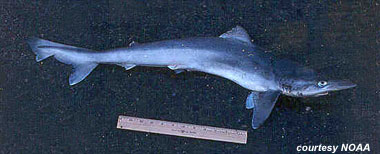
Galeorhinus galeus
This abundant, migrating, schooling shark is a strong swimmer that can travel 35 miles in a day and is found from the open sea all the way inshore to the surf zone. It is slender and dusky colored, with large eyes and mouth in a pointed snout, triangular fins, and a strong, asymmetrical tabbed caudal (tail) fin. Also called a soupfin shark, they are sought after for the fin trade despite warnings of mercury in their flesh, and the population is considered vulnerable in the wild. They can grow well to over 6 feet long, and eat smaller bony fish as well as some invertebrates.
Order – Carcharhiniformes
Family – Triakidae
Genus – Galeorhinus
Species – galeus
Common Names
English language common names include tope shark, eastern school shark, flake, greyboy, greyshark, Penny’s dog, schnapper shark, school shark, sharpie shark, soupfin shark, Sweet William shark, tope oil shark, tope school shark, tope soupfin shark, and vitamin shark. Other common names from around the globe are aceitero (Spanish), Australische haai (Dutch), Australischer Hundshai (German), bethaj (Swedish), biethaj (German), bostrich (Spanish), bostrio (Spanish), cação (Portuguese), cagnot (French), cámari (Spanish), camgöz baligi (Turkish), can negro (Italian), canesca (Italian), canicule (French), cazon (Spanish), chien de mer (French), cuero (Spanish), galeo (Italian), galéos drossitis (Greek), gat (French), Gemeine Meersau (German), gráháfur (Icelandic), gråhai (Norwegian), Großer Hundshai (German), halt (French), harmaahai (Finnish), haute (French), hundshai (German), kalb (Arabic), kapeta (Maori), karishan (Hebrew), kelb il bahar (Arabic), lamie (French), lamiola (French), makohuarau (Maori), mazzola (Maltese), milandre (French), musola corallo (Spanish), pal (French), pallon (French), paroun (French), pas butor (Serbian), perna-de-moça (Portuguese), peshk qen (Albanian), rechin de supa (Rumanian), ruwe haai (Dutch), Schulhai (German), skylogaleus (Greek), skylos drossiti (Greek), sopvinhaai (Afrikaans), tiburón de aleta (Spanish), tollo (Spanish), tollos (Spanish), touille (French), tupere (Maori), uwii guuga (Haida), and vaalhaai (Afrikaans).
Importance to Humans
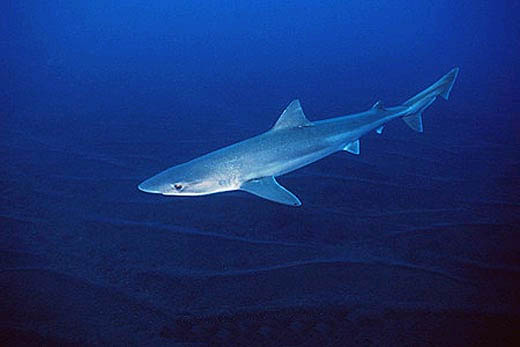
This species, also referred to as the soupfin shark, is highly prized for its fins that are used in shark fin soup in Asia. It is harvested throughout its range including off the coast of California where it is historically considered one of the top fisheries with an established market. Other locations where this species is considered important in the fisheries include Uruguay, Argentina, and Australia. The meat is considered excellent for human consumption and is marketed fresh, dried-salted and frozen. The tope shark’s skin is made into leather products.
Recreation fishers commonly capture tope sharks with rod and reel in waters off the United Kingdom, South Africa, and California. The tope shark provides a good fight when hooked, giving anglers a challenge when trying to land it.
The tope shark adapts well to captivity if captured and handled with care therefore making it suitable for public display aquaria.
Danger to Humans
The tope shark is considered harmless to humans due to its small size and its preference for small prey items. However, according to the International Shark Attack File, one unprovoked attack on a human has been attributed to this species. The tope shark should be treated cautiously if captured and landed to avoid injuries.
High levels of mercury have been detected in the flesh of the tope shark, causing the reduction or restrictions on this fishery in some locations.
Conservation
Currently listed as “Vulnerable” globally and “Near Threatened” for New Zealand by the World Conservation Union (IUCN). The worldwide population of the tope shark has declined significantly in the past 60-75 years. This is due to the shark’s slow maturity and low productivity as well as fishing pressure throughout its range. The tope shark has been commercially harvested in Australian and New Zealand waters for over 50 years. This region currently has the only management plan in place to aid the recovery of tope shark stocks.
> Check the status of the tope shark at the IUCN website.
Geographical Distribution
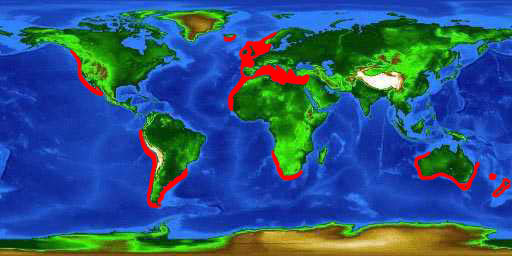
The tope shark occurs in temperate and subtropical seas between 68°N – 55°S latitude. In the western Atlantic Ocean, its range is limited from southern Brazil to Argentina while in the eastern Atlantic it can be found from Iceland to South Africa, including the Mediterranean Sea. In the western Indian Ocean region, the tope shark resides only in waters off South Africa. Distribution in the southwestern Pacific Ocean occurs in waters off Australia and New Zealand while in the eastern Pacific Ocean this shark lives in waters from British Columbia, Canada, south to Baja California (U.S.) and the Gulf of California in Mexico as well as waters off Peru and Chile.
Habitat
The tope shark is an abundant species that resides in continental and insular waters including shallow bays. It is also found in offshore waters as well as in the surf zone. This shark commonly occurs near the bottom substrate at depths to 1,804 feet (550 m). It also is pelagic in open waters as evidenced by capture on floating longlines in deep waters.
At the higher latitudes in its range, the tope shark is a highly migratory species. In some locations, small schools of tope sharks moved toward the poles during the summer and toward the equator during the cool winter months. These sharks are strong swimmers, capable of swimming up to 35 miles (56 km) per day.
Schools of tope sharks display partial segregation by sex and size. In waters off California (U.S.) during the early 20th century, there was a change in dominance of adult males to adult females from north to south with equal numbers of both sexes in waters off central California. Exceptions to this segregation occurred only at the pupping grounds in southern inshore locations where females dominated.
Biology

Distinctive Features
The tope shark is a large, slender houndshark (Family Triakidae), with a long snout and large mouth. Pronounced spiracles are located just behind the large, almond-shaped eyes. The first dorsal fin is much larger than the second dorsal. The second dorsal fin is located nearly over the anal fin and is of approximately the same size. This same-sized dorsal and anal fin measurement along with the large terminal caudal tab which extends about half the length of the dorsal caudal margin distinguishes this shark from other houndsharks.
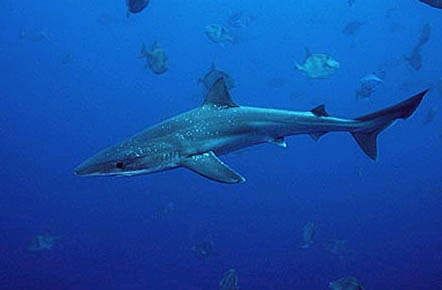
Coloration
The color of the tope shark ranges from bluish to dusky gray on the dorsal surface, fading to a white ventral side. Young individuals less than 2 feet (61 cm) in length have black-tipped dorsal and caudal fins, and a white trailing edge on the pectoral fins.
Dentition
The blade-like teeth of the tope shark have oblique cusps and distal cusplets in both jaws.
Size, Age, and Growth
The maximum reported size for this shark species is 6.3 feet (193 cm) total length for a male specimen and 6.4 feet (195 cm) total length for a female. The maximum published weight of the tope shark is 98.5 pounds (44.7 kg). It is believed that the tope shark has a life span of up to 55 years. Males reach maturity at approximately 5 feet (152 cm) in length at an age of 12-17 years while females mature at about 5.8 feet (177 cm) in length correlating to an age of 13-15 years.
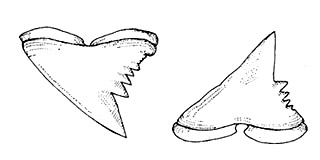
One study in the waters off the Azores determined growth rates of juveniles to be approximately 3.9 inches (10 cm) per year for the first 6 years of life with growth slowing as the shark approaches maturity.
Food Habits
The tope shark feeds on a variety of fishes including pilchards, herring, sardines, anchovies, salmon, smelt, hake, cod, midshipmen, flyingfish, barracuda, mackerel, tuna, croakers, wrasses, damselfishes, gobies, kelpfish, sole, halibut, scorpionfish, and sculpins. Invertebrate prey items of the tope shark include squid, octopus, crabs, marine snails, and sea urchins.
Reproduction
This species is ovoviviparous without a yolk sac placenta. Mating occurs during the spring months. After an approximately year-long gestation period, the females move into shallow estuaries and bays to give birth. Known locations of nursery areas off the state of California (U.S.) includes San Francisco, Humboldt, and Tomales Bays. Each litter numbers from 6 to 52 pups, dependent upon the size of the mother. Each pup measures 12-14 inches (30-35 cm) in length. The pups remain in the shallow nursery areas for one to two years before moving offshore.
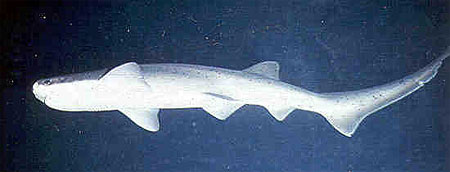
Predators
Predators of the tope shark include the white shark (Carcharodon carcharias) and the sharpnose sevengill shark (Heptranchias perlo). Potential predators include other large sharks as well as marine mammals including California sea lions (Zalophus californianus).Parasites
Anthobothrium galeorhini n. sp. (Eucestoda: Phyllobothriidae) is a known parasite of the tope shark. It has been collected from the spiral intestine of an individual in the Atlantic coastal region.
Taxonomy
Linnaeus originally described the tope shark as Squalus galeus in 1758. However, this name was changed later that year to Galeorhinus galeus (Linnaeus, 1758). The genus Galeorhinus is derived from the Greek words “galeos” meaning a shark and “rhinos” which means nose. This species is a member of the Family Triakidae, also referred to as the houndsharks, that includes a total of 33 species. Synonyms appearing in past scientific literature referring to this species include Galeus vulgaris Fleming 1828, Galeus canis Bonaparte 1834, Galeus nilssoni Bonaparte 1846, Galeus communis Owen 1853, Galeus linnei Malm 1877, Galeus australis Macleay 1881, Galeorhinus australis Macleay 1881, Galeorhinus zyopterus Jordan & Gilbert 1883, Galeus zyopterus Jordan & Gilbert 1883,Galeorhinus chilensis Perez Canto 1886, Galeus chilensis Perez Canto 1886, Galeus molinae Philippi 1887,Carcharhinus cyrano Whitley 1930, and Galeorhinus vitaminicus de Buen 1950.
Prepared by: Cathleen Bester